Congratulations! You have taken the leap to start your own handmade business!
Not many artists would take the step and put aside the fear of failure and fear of the unknown and try their handmade business venture.
If you’re an artist or someone who wants to follow your passion for selling handmade items, you’re in the right place.
A successful handmade business requires thorough planning and execution.
We have divided this in-depth guide into two parts. The initial part helps you with your planning and market research for your handmade business.
The second part helps you execute and get your first potential sale. With the right effort and time, you can get your handmade or art business off the ground and running.
Here’s a peek into the contents of the article. Feel free to navigate the part that you’d like to read.
- Why you should sell handmade items
- What types of handmade items can you sell?
- What are the best places to sell handmade items?
- Selling handmade items locally
- Selling handmade items online
- Steps to take before you set up your handmade business
- During your store set up
- You launched your handmade business… Now what?
Let’s first get the basics right.
Why you should sell handmade items
You might have already decided to sell handmade products because you’re passionate about it or want a passive income. But you should also know the unique reasons why your customers would prefer buying handmade items.
We live in an era of machines and AI. It’s the personal touch that is missing these days.
Uniqueness, personalization, and quality – These are some things people think of when buying handmade products.
Here are a few other reasons:
- As awareness to support local businesses and handmade artists is growing, the handmade business has become one of the most sought-after choices.
- Depending on your business scale, it can easily fit into your schedule, making it a suitable business venture or a side hustle.
- Starting a handmade business often requires less initial investment compared to other types of businesses, making it accessible to a wide range of people.
- You have control over design, pricing, marketing, and business decisions, offering a sense of autonomy and entrepreneurship.
- Strong and supportive marketplaces like Etsy and Amazon Handmade provide global exposure, connecting handmade sellers with a vast customer base.
- Joining the handmade community allows you to connect with like-minded creators, share insights, and gain support from fellow artisans.
- The most common reason, crafting and creating can be therapeutic, offering a fulfilling way to express yourself while also generating income.
- Most handmade items are made of affordable materials so that you can sell them at significant profits.
- Handmade businesses can be agile. You can quickly adapt to changing trends and customer preferences, offering custom and unique solutions.
What types of handmade items can you sell?
Creativity has no bounds. To give you an initial idea, here is a list of 15 different handmade products you can sell. You can expand your interests based on interest and niche.
| Item Name | Skills Required | Budget | Marketplaces to Sell On | Profitability |
|---|---|---|---|---|
| Handcrafted Jewelry | Jewelry making, design | Medium | Etsy, Amazon Handmade | Medium |
| Natural Skincare | Formulation, skincare knowledge | Medium | Shopify, Etsy, Amazon | Medium |
| Custom Art Prints | Art, graphic design | Low | Etsy, Society6, Redbubble | Low to Medium |
| Handmade Candles | Candle making, fragrance | Low | Etsy, Shopify, Amazon | Medium |
| Pet Toys and Crafts | Creative design | Low to Medium | Etsy, Amazon | Medium |
| Handknit Accessories | Knitting, crochet | Low | Etsy, eBay, Amazon Handmade | Low to Medium |
| Personalized Gifts | Creative design, personalization | Low | Etsy, Shopify, eBay | Medium |
| Organic Baby Clothes | Sewing, eco-friendly practices | Medium | Etsy, Shopify, Amazon | Medium |
| Wooden Home Decor | Woodworking, crafting | Medium | Etsy, Shopify, Amazon Handmade | Medium |
| Handmade Soap | Soap making, skincare knowledge | Low | Etsy, Shopify, Amazon | Medium |
| Custom Phone Cases | Graphic design, personalization | Low | Etsy, Shopify, eBay | Low to Medium |
| Eco-Friendly Products | Sustainable practices, design | Medium | Etsy, Shopify, Amazon | Medium |
| Leather Goods | Leatherworking, crafting | Medium | Etsy, Shopify, Amazon | Medium |
| Hand-painted Ceramics | Ceramics, painting | Medium | Etsy, Amazon Handmade | Low to Medium |
| Unique Planters | Pottery, design | Medium | Etsy, Shopify, Amazon | Medium |
| Personalized Jewelry | Jewelry making, personalization | Low | Etsy, Shopify, Amazon | Low to Medium |
What are the best places to sell handmade items
This is the most common question that artists ask all the time.
Well, you can sell handmade items locally in your area, online, or both. Let’s explore all the options one by one.
Selling handmade items locally
Most artists prefer selling handmade items in local stores and markets. You need to start by doing some research in your locality.
Flea Markets
Flea markets bring together a wide range of vendors offering vintage, secondhand, and handmade items. Do your research before you actually sell in a flea market.
Keep your business model and payment methods simple unless it is required. Certain states, such as Connecticut of the US, mandate flea market vendors to have permits for selling and collecting sales tax. We suggest you verify local guidelines to ensure compliant participation in flea markets within legal bounds.
Besides, you should have a good product, but your marketing and branding efforts should also make you stand out from the crowd.

Craft Fairs and Art Markets
Craft fairs and art markets are events specifically organized to showcase handmade items. They attract a diverse crowd interested in unique and creative products ranging from glass art, ceramics, metalwork, textiles, woodwork, and more.
For instance, you could set up a local holiday craft fair booth to display your hand-painted ornaments, pottery, or custom-made jewelry.
Farmers’ Markets
They are excellent venues for selling handmade items, especially if they have a section dedicated to artisanal products.
For example, you could sell handcrafted soaps, candles, or textile goods alongside local produce and foods.
Community and Holiday Bazaars
Community bazaars are often organized by local organizations or schools. These events provide opportunities to showcase your products during special occasions. Participating in these bazaars can be a fantastic opportunity to showcase and sell your handmade items.
Local Boutiques and Shops
You can sell in local boutiques and shops that align with your style. Make a list of shops in your area. Go to the store as a customer and make notes on the condition, pricing, employees, etc. Analyze if your products fit the store. Reach out to the store owner, be confident, and show that you did your research and get a deal to sell your products in their boutique or stores.
Tip: Social media is yet another good idea to get started with these conversations.
Art Galleries and Studios
Collaborate with local art galleries or studios that may offer space for you to display and sell your art. For example, if you’re a painter, you could showcase your canvas artwork in an art gallery.

Selling at Carnivals and Festivals
Selling handmade items at carnivals requires an eye-catching booth setup that reflects your brand. Opt for vibrant displays, arrange products creatively, and offer unique items that resonate with the festive atmosphere. Interact with your customers in a friendly manner. You can discuss your craft’s story and consider offering exclusive carnival-themed pieces.
Simplify transactions with multiple payment options, and don’t forget to adhere to any event-specific rules and guidelines.
These local selling options allow you to interact directly with customers, receive immediate feedback, and establish a personal connection. Each option presents a unique opportunity to showcase your craftsmanship, tell your brand’s story, and contribute to your local creative community. This way, you can hone your skills and make better or more handmade items in no time.
Selling handmade items online
Nowadays, selling handmade products online is one of the most viable options for a business owner. From your own website to niche marketplaces, here’s a list of places to sell your craft and handmade products online.
Sell on your website
Though selling on your own website is hard, it tops our list because it gives you more freedom and greater control over something invaluable – Your customer data.
Besides, you can better manage your sales, customer journey, pricing, branding, and customer experience. With advancements in technology and AI, building a website has become much easier. However, you still need basic coding and marketing skills or a team to help you.
You can build a website from scratch or use an e-commerce platform that suits your needs. Popular options include Shopify, WooCommerce (for WordPress users), BigCommerce, and Squarespace. These platforms offer user-friendly interfaces and customizable templates.
Selling on Etsy
Etsy is a leading platform for artisans and crafters. It offers a user-friendly interface and tools to help you set up your shop, list products, manage orders, and engage with customers. Etsy’s strong search functionality makes it easier for potential buyers to discover your handmade items within a niche community of creative shoppers.
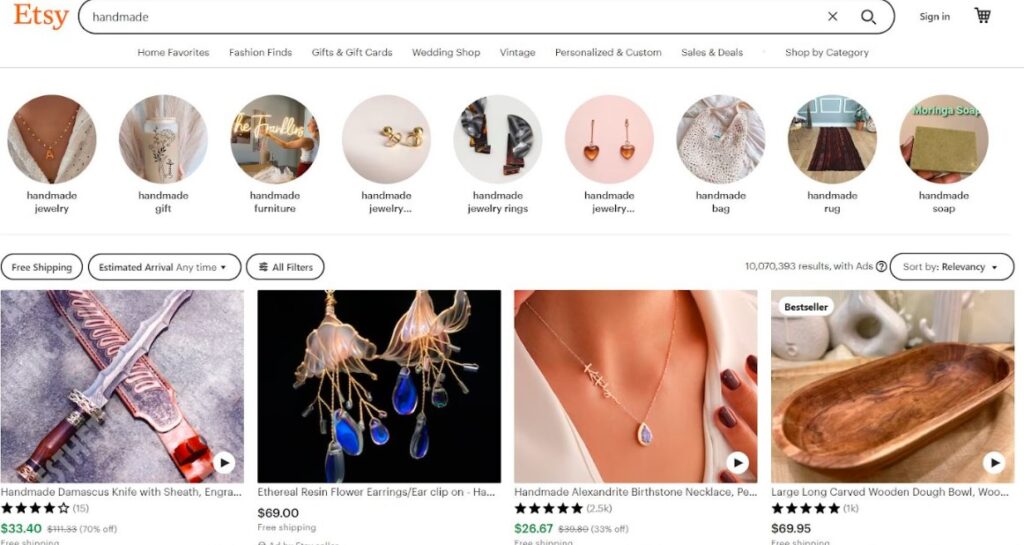
Here are a few reasons to get started on Etsy:
- It’s easy to get started with your store, set up, listings, and order management, even if you’re new to e-commerce.
- Etsy’s primary focus is on handmade, vintage, and unique items, providing a ready-made audience seeking artisanal products.
- The platform’s global presence allows you to reach customers worldwide and tap into a diverse customer base.
- Etsy has over 4.9 million active sellers and around 90 million active buyers.
- Setting up a shop on Etsy requires minimal financial investment compared to building a standalone e-commerce website.
The list goes on. Etsy offers a platform that aligns well with the needs and aspirations of artisans and creators. Keep in mind that staying updated with the latest platform changes and trends is crucial for maximizing your success on Etsy.
Amazon Handmade
Amazon Handmade is Amazon’s specialized section for artisans. While it has a larger customer base, it also has specific requirements for products to ensure their handmade nature. With Amazon’s extensive shipping and customer service infrastructure, you can reach a wide audience while leveraging their trusted platform.
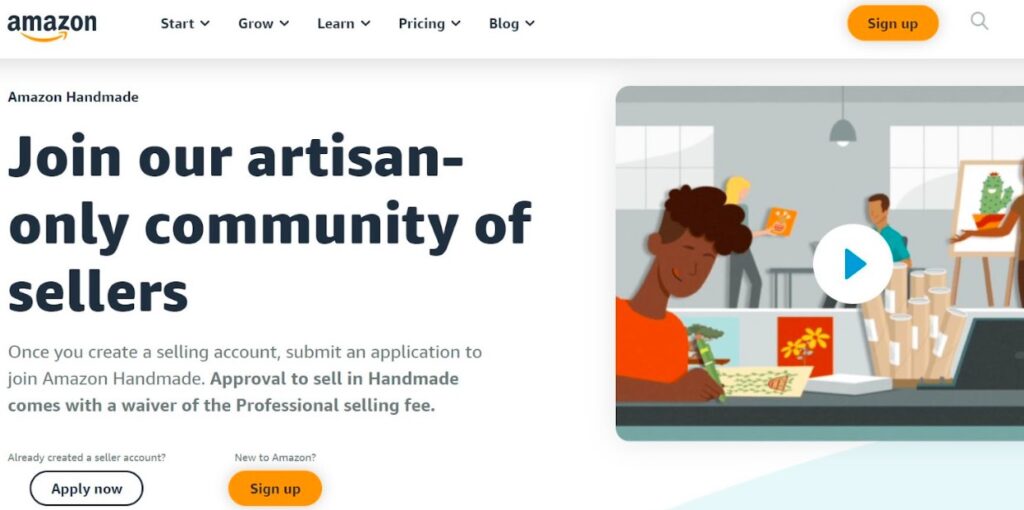
Social Media Platforms
Social media platforms like Instagram, Facebook, and Pinterest provide opportunities to showcase your products visually. Utilize high-quality images, engaging captions, and relevant hashtags to attract and engage potential buyers directly.
Online Marketplaces
Platforms like eBay, Zibbet, and Bonanza cater to a range of products, including handmade items. They allow you to list your products alongside others, often with less stringent requirements compared to dedicated handmade platforms.
Print-on-Demand Sites
If you create digital designs or artwork, print-on-demand platforms like Printify let you offer your designs on various products like apparel, mugs, and home decor. You upload your designs, and the platform handles printing, fulfillment, and shipping.
Craft and Art Marketplaces
Sites like Folksy and Aftcra specifically cater to handmade crafts and arts. These platforms offer a community of artists and crafters and can help you target a more niche audience.
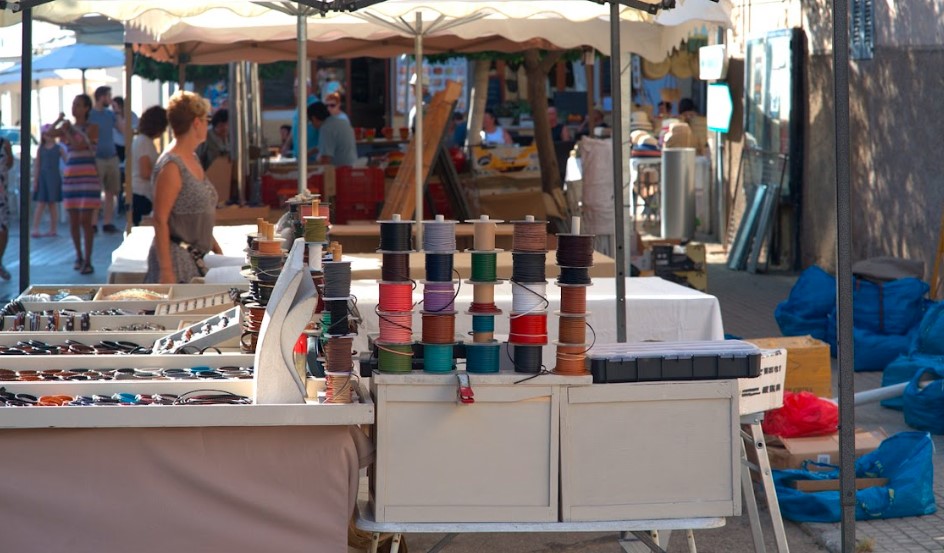
Niche Online Communities
You can join online forums or communities related to your craft or niche. Engage in discussions, share your expertise, and subtly promote your handmade items to a targeted audience that shares your interests.
Subscription Boxes
Offering curated subscription boxes with your handmade items allows customers to receive a surprise assortment of your products regularly. Platforms like Cratejoy provide tools to set up and manage subscription offerings.
Online Auctions
Platforms like eBay Auctions let you list your items for auction, potentially sparking bidding wars that drive up prices. This method works well for unique or rare creations.
Handmade-focused blogs
If you enjoy writing, starting a blog focused on your craft can build an audience and offer your creations for sale. It’s a more indirect approach that showcases your expertise and creative process. However, if your blog is search engine optimized, it can drive your traffic in the long run, thereby potential chances to gain organic sales.
Each of these methods presents unique advantages. Along with the above, you can also consider selling in virtual craft shows and online art galleries. Before you decide on a specific marketplace, you should also consider your target audience, the nature of your handmade items, and your overall business goals.
Steps to take before you set up your handmade business
This is the second part of the article that helps you set up, launch, and promote your handmade business to get your first sale.
The image below summarizes the entire process.
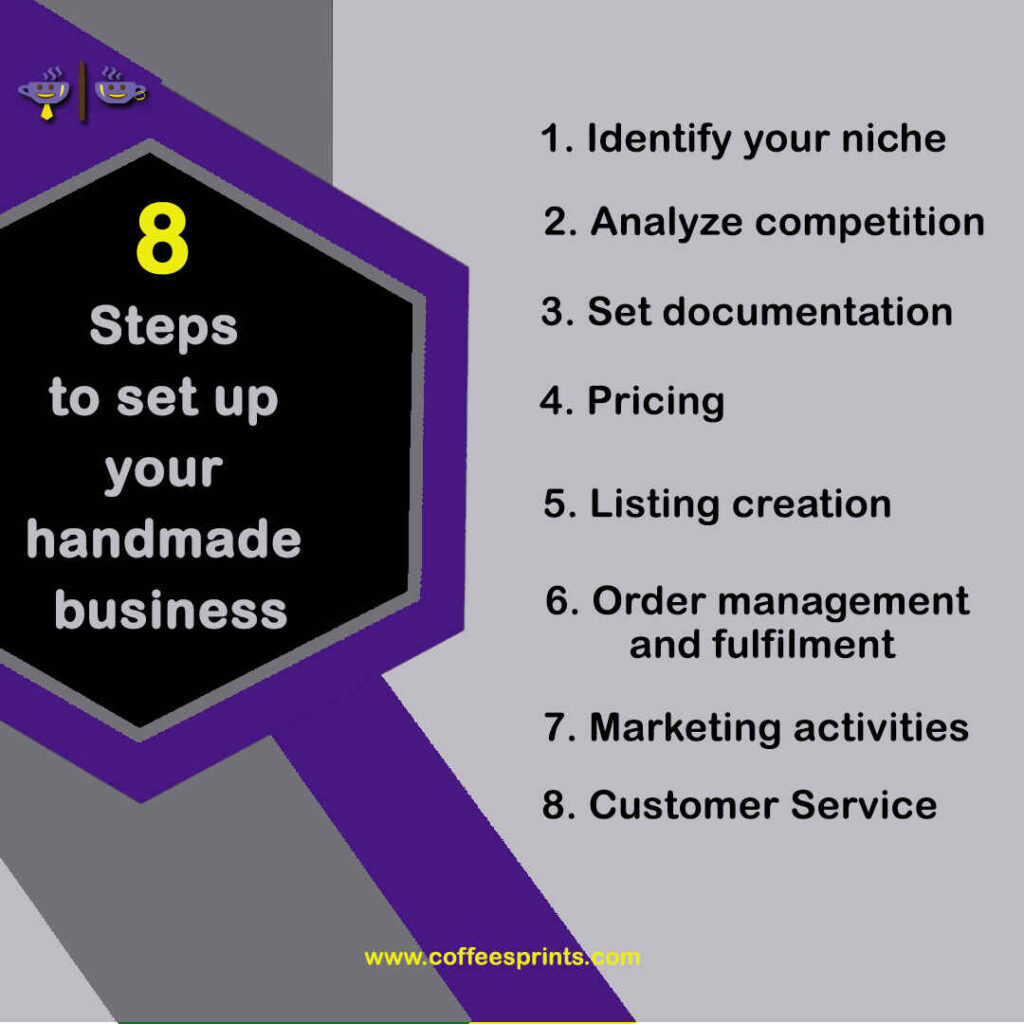
Identify Your Niche
Most creators and artists who aspire to sell their products online usually have a good idea of their niche. However, if you possess multiple talents, it’s important to focus on the one that aligns with your passion and profitability.
For instance, if you excel at making candles and are a skilled painter, consider mastering one of these skills before expanding. This focus will help you create a unique selling proposition and build a strong foundation for your business.
Analyze competition and market trends
Competitor analysis and market research are crucial steps for any business. Before you launch, assess your competitors’ offerings, pricing, and branding to understand their unique selling points.
Monitoring market trends enables adaptation to changing consumer preferences and emerging niches. Analyzing top-searched SEO keywords and social media engagement aids allows you to refine your product and marketing strategies. This way, you can innovate and strategically position yourself for sustained growth and customer appeal.
Choose the Right Business Model
Before you decide to sell your handmade business, you need to select the appropriate business model that suits your long-term goals. You can choose to:
- Sell on online marketplaces like Etsy or Amazon Handmade
- Set up your own e-commerce website
- Participate in craft fairs and local markets
Each model has pros and cons, so choosing the one that best suits your products, target audience, and resources is important.
Understand Requirements, Guidelines, and Documents
Just like any other business model, it’s crucial to understand the legal and regulatory requirements in your region. This may include obtaining a business license, registering your business name, and understanding tax obligations. You should also comply with the various government regulations that exist to protect the business owner and the customer. Research such guidelines to ensure compliance and avoid potential issues down the road.
Address Trademark and Copyright Concerns
When running a creative business, especially one that involves items like greeting cards, jewelry, and other artistic creations, it’s important to be aware of trademark and copyright issues. Inspiration drawn from popular characters, movies, or existing designs can lead to potential legal problems if not handled correctly.
Here’s a closer look at some trademark and copyright considerations:
Originality and Creativity:
Ensure that your designs and products are original, not direct copies of existing work. Incorporate your unique style and artistic vision into your creations to display your brand personality and differentiate yourself from competitors.
Trademarked Characters and Logos:
Avoid using trademarked characters, logos, or symbols in your products without proper authorization. Using such elements without permission can lead to legal action for trademark infringement.
Licensing and Permissions:
If you wish to create products inspired by copyrighted characters or designs like Disney, Marvel, or DC, consider seeking licensing agreements or permissions from the copyright holders. This will allow you to legally use their intellectual property in your creations.
Fair Use:
Familiarize yourself with the concept of “fair use” in copyright law. Fair use allows limited use of copyrighted material without permission for commentary, criticism, and parody purposes. However, the boundaries of fair use can be complex, so we suggest you seek legal advice if you’re uncertain.
Original Designs:
Focus on creating original designs not influenced by copyrighted or trademarked content. This will help you build a unique brand identity and reduce the risk of legal disputes.
Remember to take proactive steps to address these aspects, so you can protect your business and showcase your creativity with confidence.
During your store set up
In this step, ensure you have all the things you need to get your handmade products in front of your customers.
Pricing handmade for profits: Gaining clarity on this endless debate
Putting a price on the item you’ve poured your heart into would be the least favorite part of the work for most artists (after legal documentation, though). But it is extremely important to you, your shoppers, and your business.
Here are our simple steps to price your handmade items.
Cover all costs
By all, we mean manufacturing, operational, and additional costs. You should account for production costs, labor costs, and listing costs. Do not skip any kind of expense you need to make to get the final product.
Include your profit margins
Many handmade sellers struggle with this. In fact, most artists stop selling their craft as they don’t see a profit. We get it – You’re an artist, not a businessman. But if you want to keep your passion alive, you must factor in profit margins.
Most handmade businesses would have a 5% – 20% profit margin. It can increase or decrease based on the type of product and the MOQ (minimum order quantity). You can also set the profit margin based on your business goals.
Include markup
Markup helps you recover unexpected production costs or discounts you want to offer in case of some events or shopping season. Any retail seller should include markup so the business would remain financially viable, sustain growth, and deliver value to customers while securing profitability.
So the product price would be something like:
Total Price = Total costs + (Total costs × Markup Percentage) + Desired Profit
However, this gives you a rough idea to start with. As you develop your product, you need to factor in all the costs and scenarios and come up with a price that is deemed profitable.
Things to keep in mind to get your product pricing right
“The world of handmade is a community bound by passion and craftsmanship, the responsibility lies on each of us to uphold a thriving marketplace adorned with treasures of impeccable value and fairness.”
- Do not underprice, as you do more harm than good to your skill and business. When too many sellers undercut the market, the shoppers get a taste of cheap prices. This takes a toll on an individual’s business and prices out new makers.
- Do experiment with pricing. Several tools in the market can help you understand your competitor’s pricing strategies. Depending on your marketing tactics and competition, ensure you play around with the prices to increase sales.
- Ensure you price your handmade item in alignment with the perceived value of your product in the eyes of your customers.
- If you’re charging a premium price, ensure you communicate the benefits, value, and all the features that your customers should know
- It is okay to adjust prices based on demand fluctuations and current market trends. However, the prices shouldn’t fluctuate drastically over a short period.
- Determine different pricing structures for wholesale and retail to accommodate various distribution channels.
- Plan for occasional sales or promotions while ensuring they don’t negatively impact profitability.
- Clearly communicate pricing to customers. For instance, if you charge any additional costs for customization or shipping, ensure you communicate it to the shopper.
- If you’re selling across multiple platforms and channels, ensure you maintain consistent pricing.
Balancing these factors will help you arrive at a pricing structure that not only covers costs but also positions your handmade product competitively while ensuring profitability and sustainability.
Getting your products ready
Handmade items are known for their visual appeal. In this step, you should prepare your handmade listings for selling with proper attention to detail and effective presentation.
Here are five essential steps to get your handmade listings ready:
Compelling Descriptions: Craft detailed, engaging product descriptions. Highlight unique features, materials used, and benefits. Use clear language and provide sizing, dimensions, and care instructions.
High-Quality Images: Capture professional-quality images showcasing your items from different angles. Use natural lighting and neutral backgrounds to make your products stand out.
Keywords and Tags: Use relevant keywords and tags in your listing titles and descriptions to improve search visibility. Think about words potential buyers might use when searching for products like yours.
Variety and Options: Offer variations if applicable (e.g., size, color), providing customers with choices. Clearly state the available options and their impact on pricing and availability.
Order management and fulfillment for your handmade items
Operations management is at the heart of any business – Handmade business is no exception.
Efficient order management and shipping will take your business to the next level, especially, in an era where customers get swift deliveries within a few hours.
Here are a few tips to streamline your order management and shipping process:
- Implement an efficient order management system that consolidates incoming orders from various sales channels. This streamlines processing and reduces the risk of errors.
- Maintain accurate inventory records to prevent overselling and manage stock levels effectively. Consider integrating inventory management software with your order system and streamline your labeling process.
- Keep customers informed about their order status through automated notifications. This reduces inquiries and enhances the overall customer experience.
- Clearly communicate the time it takes to process orders before shipping. Underpromise and overdeliver to exceed customer expectations.
- Group orders with similar products to optimize packaging and reduce processing time. Batch processing also minimizes errors and enhances efficiency.
- Handmade businesses are known for their personalization and quality. Try adding a personal touch and protecting products during transit.
- Offer a variety of shipping options to cater to different customer preferences, including standard, expedited, and international shipping.
- Choose reliable and cost-effective shipping carriers based on factors like delivery time, destination, and package size. Negotiate shipping rates if your volume allows.
- Provide customers with tracking numbers for their orders. This enhances transparency and lets customers monitor their shipments.
- Optimize packaging for protection while minimizing waste. Consider sustainable packaging options that align with your brand values.
- Establish clear policies for returns and exchanges. Make the process as smooth as possible to maintain customer loyalty.
- Regularly analyze order and shipping data to identify bottlenecks and areas for improvement. Adjust processes based on insights gained.
- Holidays and events are crucial periods for handmade businesses. So stay consistent and accurate with order and shipping management.
- Collect and analyze customer feedback regarding shipping experiences to identify areas for enhancement.
Remember that effective operations and fulfillment play a crucial role in customer satisfaction, repeat business, and word-of-mouth recommendations.
You launched your handmade business… Now what?
One of the common mistakes I see small business owners making is forgetting that launching their products is only half the task. After the launch, one should take the opportunity to market and refine the products to increase the momentum.
Post-Launch Marketing Strategies
Here are some post-launch activities to consider:
Social Media: Maintain an active presence on social media platforms relevant to your target audience. Share behind-the-scenes content, updates on new products, and interact with followers to build a loyal community.
Collect and Act on Feedback: Encourage customers to provide feedback on their purchases. Use this feedback to improve your products, customer service, and overall shopping experience. Also, you can use their feedback as testimonials.
Refine Your Listings and Pricing: Continuously review and update your product listings. Add new photos, refresh descriptions, and adjust pricing based on market trends and customer preferences.
Expand Product Range: Introduce new products or variations to keep your offerings fresh and attract repeat customers. Consider seasonal items or limited-edition releases.
Email Marketing: Start an email newsletter to inform customers about new arrivals, promotions, and updates. Build and maintain a mailing list for direct communication.
Collaborations and Partnerships: Explore collaborations with other artisans, influencers, or complementary businesses. Collaborations can help you tap into new audiences and markets.
Regular Content Creation: Maintain a blog or create content that aligns with your brand. Share DIY tutorials, industry insights, or stories related to your craft to engage your audience.
Customer Appreciation: Show gratitude to your customers through special offers, exclusive discounts, or loyalty programs. Acknowledge their support and make them feel valued.
Optimize SEO: Continuously work on improving your website or Etsy listings’ SEO. Regularly update keywords, meta descriptions, and content to boost your online visibility.
Analyze Sales Data: Regularly review your sales data and analytics. Identify trends, popular products, and customer demographics to make informed business decisions.
Networking and Events: Attend local craft fairs, workshops, and events to connect with fellow artisans and potential customers. Building connections within your industry can lead to valuable opportunities.
Monitor Competitors: Keep an eye on your competitors to stay updated on industry trends, marketing trends, social media, and innovation in your field.
The neglected part of the business – Why you shouldn’t
Customer service is sometimes neglected due to a lack of awareness about its impact on business success. Handmade businesses should prioritize excellent customer service as it directly affects customer satisfaction, loyalty, and brand reputation. Here’s how you should treat customer service for your handmade business:
Prioritize meaningful interactions: Engage in a genuine conversation with your customer. It has the power to shape their perception of your business. Such personal interactions can leave a lasting positive impression, even if other aspects of their experience might be less memorable.
Let your customers feel special: Add those personal touches, and don’t hesitate to go the extra mile to put a smile on their faces — especially if things didn’t kick off on the best foot.
Prompt Communication: Respond promptly to customer inquiries, emails, and messages. Quick and helpful responses show that you value their time and concerns.
Transparency: Be transparent about your products, policies, and processes. Clear communication builds trust and reduces misunderstandings.
Problem Resolution: Handle customer issues and complaints with empathy and a solution-oriented mindset. Resolve problems quickly and satisfactorily.
Consistency: Deliver a consistent customer experience across all touchpoints, from your website to social media and packaging.
Underpromise, Overdeliver: Set realistic expectations and strive to exceed them. Surprise customers with small gestures like handwritten notes or extra goodies in their orders. However, it may not be feasible for repeat customers. So be wary about this strategy.
Post-Purchase Follow-Up: After a sale, follow up with customers to ensure their satisfaction. This reinforces their positive experience and encourages future interactions.
Empower Your Team: If you have employees or collaborators, empower them to deliver exceptional customer service. Provide training and guidelines to ensure consistent service quality.
Celebrate Loyalty: Recognize and reward loyal customers. Offer exclusive discounts or early access to new products as a token of appreciation.
Exceptional customer service is a competitive advantage that can set your handmade business apart. Happy customers become brand advocates, spreading positive word-of-mouth and contributing to your business’s long-term success.
Hope you found this article helpful! Let us know your thoughts in the comments below.
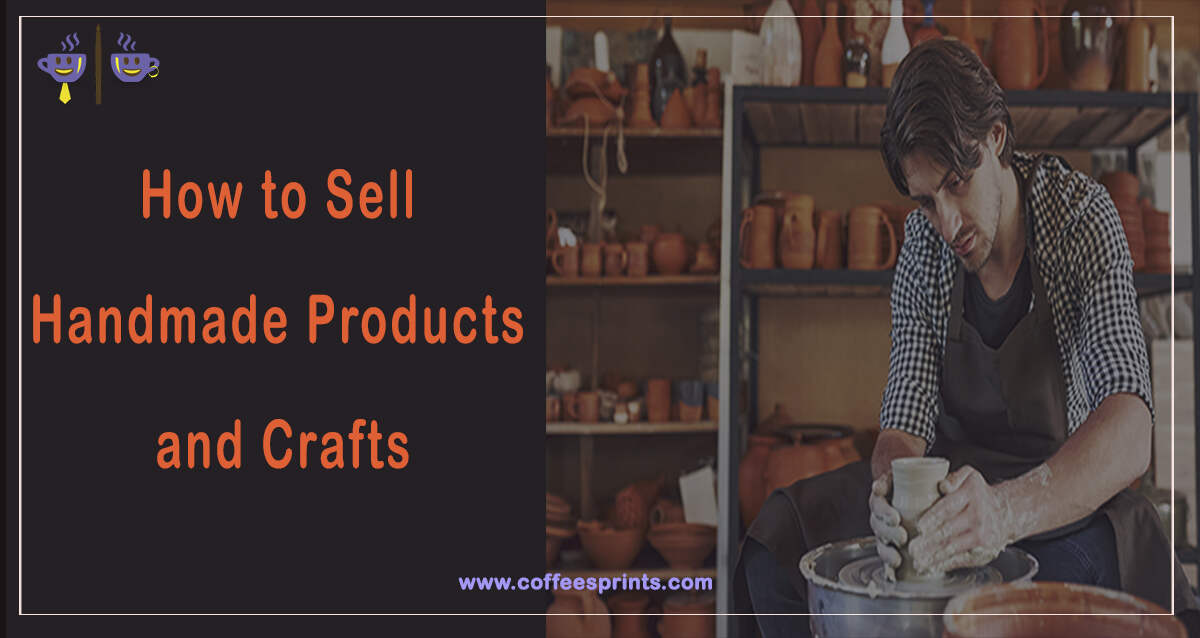
2 thoughts on “How to Sell Handmade Products and Crafts – A Complete Guide to Get Started”
Thanks for sharing great ideas!!
Thanks for the great article.